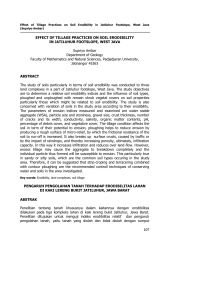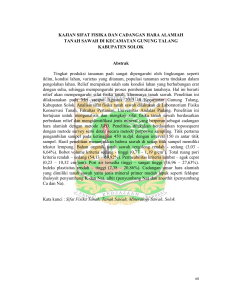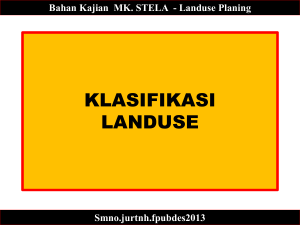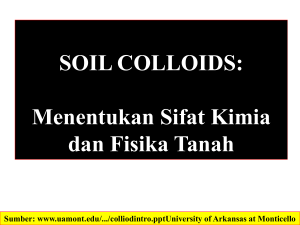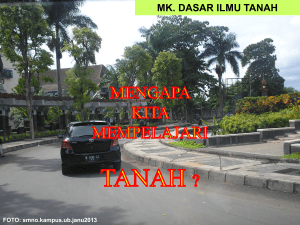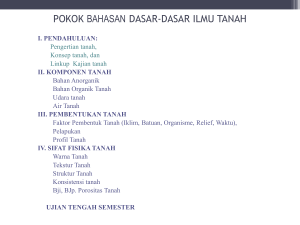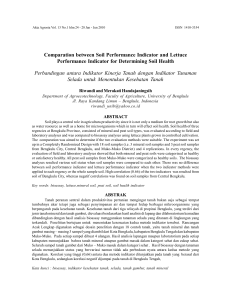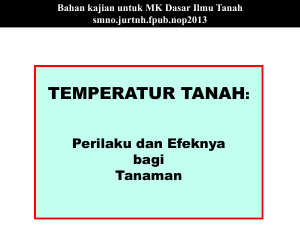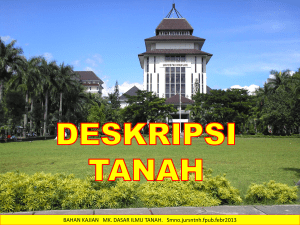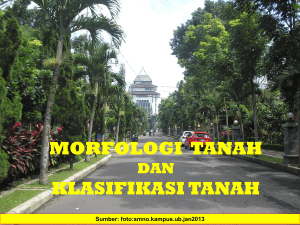kompendium kesuburan tanah dan pemupukan
advertisement
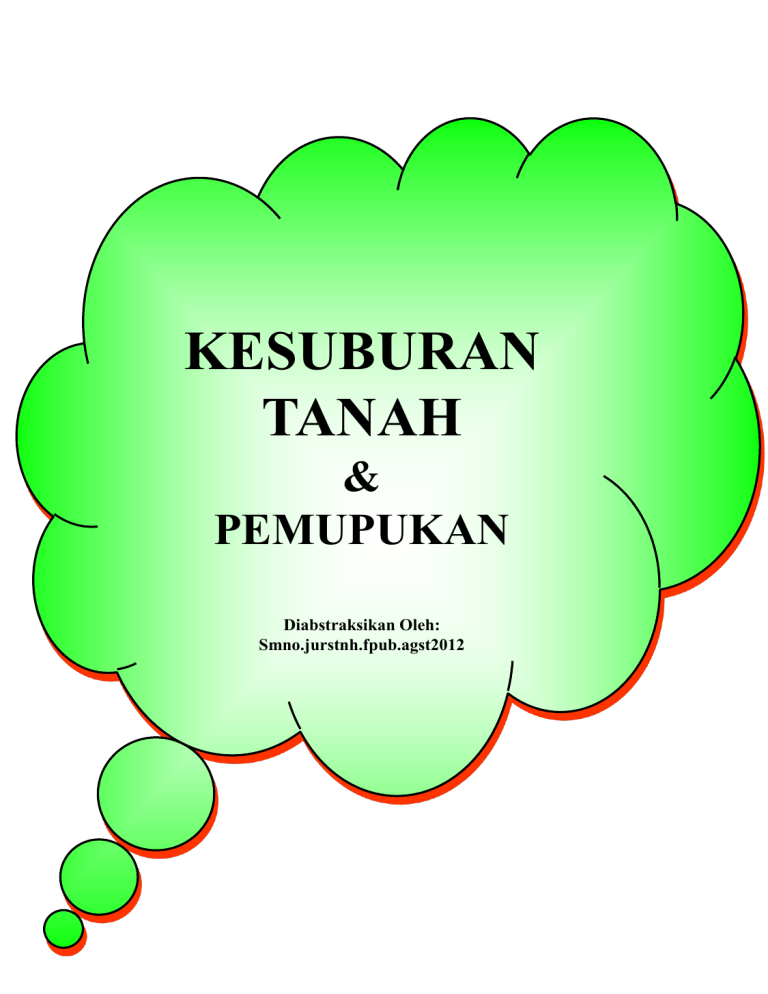
KESUBURAN TANAH & PEMUPUKAN Diabstraksikan Oleh: Smno.jurstnh.fpub.agst2012 Kesuburan tanah Kesuburan Tanah adalah kemampuan suatu tanah untuk menghasilkan produk tanaman yang diinginkan, pada lingkungan tempat tanah itu berada. Produk tanaman berupa: bunga, buah, biji, daun, umbi, getah, akar, trubus, batang, biomassa, naungan, penampilan estetika, dan lainnya. Tanah memiliki kesuburan yang berbeda-beda tergantung sejumlah faktor pembentuk tanah yang merajai di lokasi tersebut, yaitu: Bahan induk, Iklim, Relief, Organisme, dan Waktu. Tanah merupakan fokus utama dalam pembahasan ilmu kesuburan tanah, sedangkan “tanaman” merupakan indikator utama bagi “kesuburan tanah”. Diunduh dari: http://id.wikipedia.org/wiki/Kesuburan_tanah.. Cara Menjaga Kesuburan Tanah Untuk menjaga kesuburan tanah bisa dilakukan dengan cara sebagai berikut : 1. Gunakan jerami. Pada tanah sawah, biasanya setelah panen padi kita selalu membuang dan membiarkan jerami ditumpuk di pinggir sawah. Padahal jerami itu bisa kita manfaatkan untuk menyuburkan tanah. Sebarkan jerami tersebut ke lahan dan ratakan. Kemudian taburkan serbuk dolomit ke atas jerami tersebut. Fungsi dolomit untuk membantu mempercepat pelapukan daun jerami dan bisa mengatur tingkat keasaman tanah sehingga tanah bisa lebih matang dan lahan bisa segera ditanami.Setelah sekitar seminggu lahan tersebut bisa langsung dibajak dan jerami yang belum lapuk bisa dibenamkan ke dalam tanah. 2. Lubang resapan Biopori. Pada taman atau halaman rumah bisa kita lakukan metode biopori. Caranya lubangi tanah secara tegak lurus dengan menggunakan pipa besi dengan diameter sekitar 10-20 cm dan kedalaman tanah sekitar 100 cm. Jarak antar lubang resapan biopori adalah 50-100 cm. Kebutuhan jumlah lubang resapan biopori yang diperlukan berdasarkan luas tutupan bangunan. Bila tutupan bangunan dengan luas 20 m2 diperlukan lubang resapan biopori sebanyak 3 unit dan setiap tambahan luas tutupan bangunan 7 m2 diperluhan tambahan 1 unit lubang resapan biopori. Dalam pemeliharaannya lubang resapan biopori ini diisi sampah organik secara berkala dan mengambil sampah tersebut setelah menjadi kompos diperkirakan 2-3 bulan setelah terjadi proses pelapukan. 3. Tanaman Crotalaria.Untuk lahan kritis bisa dimanfaatkan untuk ditanami tanaman crotalaria. Akar tanaman crotalaria bisa mengikat nitrogen dan unsur lain yang sangat dibutuhkan tanah untuk menjadi subur. Daun dan batang tanaman crotalaria sangat baik dijadikan pupuk hijau (kompos) karena mengandung unsur-unsur yang sangat dibutuhkan tanah dan tanaman dibanding pupuk hijau dari tanaman lain. Diunduh dari: http://rishadicorp.blogspot.com/2011/03/cara-menjaga-kesuburan-tanah.html.. Mengelola kesuburan tanah dapat dilakukan dengan metode-metode vegetatif dan mekanik Upaya yang dapat dilakukan untuk menjaga keseburan tanah sebagai berikut: a. Metode vegetatif dilakukan dengan cara-cara : 1. Penanaman tanaman secara berjalur tegak lulus terhadap arah aliran(strip cropping). 2. Penanaman tanaman secara berjalur sejajar garis kontur (contour strip cropping). 3. Penutupan lahan yang memiliki lereng curam dengan tanaman keras (buffering) 4. Penanaman tanaman secara permanen untuk melindungi tanah dari tiupan angin (wind breaks). b. Metode mekanik yang umum dilakukan ADALAH: 1. Pengolahan lahan sejajar garis kontur (contour tilage).pengolahan lahan dengan cara ini bertujuan untuk membuat pola ronggarongga tanah sejajar kontul dan membentuk igir-igir kecil yang dapat memperlambat alilan air dan memperbesar infiltrasi air 2. Penterasan lahan miring (terracering).penterasan bertujuan untuk mengurangi panjang lereng dan memperkecil kemiringan lereng sehingga dapat memperlambat alilan air. 3. Pembuatan pematang (guludan)dan saluran air sejajar garis kontur.pembuatan pematangan bertujuan untuk menahan alilan air. 4. Pembuatan cekdam.pembuatan cekdam bertujuan untuk memperbendung alilan air yang melewati parit-parit sehingga material tanah hasil erosi yang terangkut aliran tertahan dan terendapkan adannya cekdam menyebabkan erosi tanah dapat dikendalikan,lapisan tanah menebal,dan produktivitas tanah meningkat . Diunduh dari: http://lukmanituagam.blogspot.com/2011/03/menjaga-kesuburan-tanah.html.. LIMA FAKTOR PENGELOLA AN Pengendalian GULMA. TANAH PERGILIRAN TANAMAN PENGENDALIAN HAMA & PENYAKIT PENYEDIAAN UNSUR HARA Penyediaan AIR YANG CUKUP, Sesuai dengan kebutuhan tanaman DINAMIK A HARA TANAH Mempertahankan jumlah optimum unsur hara hanya dapat terlaksana dengan menciptakan keseimbangan yang baik antara penambahan dan kehilangannya Benefits of Organic Matter Benefits of Organic Matter Reduces compaction and bulk density Provides a food source for microorganisms Increases activities of earthworms and other soil critters Increases soil CEC Stabilizes nutrients Builds soil friability and tilth Reduces soil splash Carbon Sequestration C cycling in agroecosystems has a significant impact at the global scale because agriculture occupies approximately 11% of the land surface area of the earth. POKOK-POKOK PENGELOLAAN KESUBURAN TANAH. 1. Suplai nitrogen dari: Sisa Tanaman Pupuk kandang Hujan & irigasi Pupuk nitrogen Tanaman biasa Tanaman legume Pupuk hijau Kompos 2. Penambahan bahan organik melalui: Sisa tanaman legume dan non legume Pupuk kandang Pupuk hijau 3. Penambahan kapur bila diperlukan Batu kapur kalsit atau dolomit yg biasa dilakukan 4. Penambahan fosfat: Pupuk superfosfat, atau Pupuk lainnya 5. Penambahan kalium tersedia: Pupuk kandang Sisa tanaman Pupuk Kalium 6. Kekurangan belerang diatasi dg: Belerang, gipsum, superfosfat, Amonium sulfat, Senyawa belerangdalam air hujan 7. Penambahan unsur mikro: Sebagai garam terpisah atau campuran MENGATASI KEKURANG AN NITROGEN Dinamika nitrogen Penambahan & Kehilangan N-tersedia Pengikatan Nitrogen Simbiotik Pupuk Buatan NonSimbiotik Sisa tanaman Pupuk Kandang Ntersedia dlm tanah Atmosfer Bahan Organik Panen Tanam an Hilang Pencuci an Hilang Erosi MEMPERTAHA NKAN BAHAN ORGANIK TANAH Carbon Inputs to Soil Crop residues Cover crops Compost , and Manures Carbon Substrate The majority of C enters the soil in the form of complex organic matter containing highly reduced, polymeric substances. During decomposition, energy is obtained from oxidation of the C-H bonds in the organic material. Soil Carbon Equilibrium Input primarily as plant products Output mediated by activity of decomposers It is common that from 40 to 60% of the C taken up by microorganisms is immediately released as CO2. PENTINGNYA Ca & Mg Keseimbangan Ca dan Mg Penambahan dan kehilangan Sisa tanaman & Pupuk Kandang Pupuk Komersial Ca dan Mg tersedia dalam tanah PANEN TANAMAN Hilang pencucian Mineral Tanah KAPUR Hilang Erosi MEMPERTAHANKAN KETERSEDIAAN FOSFAT. Siklus P Kehilangan & Penambahan Ptersedia Sisa tanaman Pukuk kandang Bahan Organik Tanah Terangkut tanaman Pukuk komersial Mineral Ptanah P-tersedia dalam tanah Hilang Pencucian Hilang Erosi Fiksasi KETERSEDIAAN KALIUM Tanah mineral umumnya mengandung cukup banyak kalium, kisaran 40 ton setiap hektar lapisan olah tanah. Namun demikian hanya sebagian kecil yangtersedia bagi tanaman Kehilangan & Penambahan Kalium: Sisa tanaman & Pupuk Kandang Pupuk komersial Mineral-K lambat tersedia K-tersedia tanah Terangkut tanaman Kehilangan pencucian Kehilangan erosi Kehilangan Fiksasi The Soil Food Web In 1 teaspoon of soil there are… 5 or more ------------ Earthworms Up to 100 ……………. Arthropods 10 to 20 bacterial feeders and a few fungal feeders ……. Nematodes Several thousand flagellates & amoeba One to several hundred ciliates ……. Protozoa 6-9 ft fungal strands put end to end ………. Fungi 100 million to 1 billion …………. Bacteria Classical C Pools Nonhumic substances—carbohydrates, lipids, proteins Humic substances—humic acid, fulvic acid, humin BOT berpengaruh terhadap: -Plant nutrition -Soil and Plant health -Soil physical, chemical and biological properties BOT ----- FRAKSI RINGAN The light fraction (LF) with a density of ~1.6 gm cm-3 is relatively mineral free and consists of partially decomposed plant material, fine roots and microbial biomass with a rapid turnover time. The LF is a source of readily mineralizable C and N, accounts for ~50% of total soil C and declines rapidly under cultivation. BOT --- FRAKSI BERAT --- The Heavy Fraction The heavy fraction (HF) is organic matter adsorbed onto mineral surfaces and sequestered within organomineral aggregates. The HF is less sensitive to disturbance an chemically more resistant than the LF. Bacteria vs. Fungi Bacteria are smaller than fungi and can occupy smaller pores and thus potentially have greater access to material contained within these pores. Bacteria are less disrupted than are fungi by tillage practices commonly used in agriculture. Bacteria vs. Fungi Fungi tend to be selected for by plant residues with high C/N ratios. Fungi have a greater influence on decomposition in no-till systems in which surface residues select for organisms that can withstand low water potentials and obtain nutrients from the underlying soil profile. Bacteria vs. Fungi Fungi often produce more cell wall than cytoplasmic material when starved for N, and thus can extend into new regions of the soil without requiring balanced growth conditions. The filamentous growth structure of a fungus permits it to access C in one location and nutrients in another. KANDUNGAN BAHAN ORGANIK TANAH 1. 2. 3. 4. 5. 6. How organic matter in soil influences the soil-plant relationship? Decomposed organic matter provides nutrients for plant growth (Mineralization) It determines the soil’s temperature, air ventilation, structure and water management It contains bioregulators which affects plant growth It contains bioregulators, which affects plant growth (enzymes, hormones, etc.) Its carbon and energy content is the soil’s energy battery for future use It determines the soil’s capacity to compensating, regenerating and protecting the environment regenerating and protecting the environment PENTINGNYA BOT 1. 2. 3. 4. 5. Organic material in the soil is essentially derived from residual plant and animal material, synthesised by microbes and decomposed under influence of temperature, moisture and ambient soil conditions Soil organic matter is extremely important in all soil processes Cultivation can have a significant effect on the organic matter content of the soil In essentially warm and dry areas like Southern Europe, depletion of organic matter can be rapid because the processes of decomposition are accelerated at high temperatures Generally, plant roots are not sufficiently numerous to replace the organic matter that is lost MANFAAT BOT ➢ Storehouse for nutrients ➢ Source of fertility ➢ Contributes to soil aeration thereby reducing soil compaction ➢ Important ‘building block’ for the soil structure ➢ Aids formation of stable aggregates ➢ Improves infiltration/permability ➢ Increase in storage capacity for water. ➢ Buffer against rapid changes in soil reaction (pH) ➢ Acts as an energy source for soil micro-organisms Degradation: HILANGNYA BOT 1. 2. 3. 4. During field operations, fresh topsoil becomes exposed and dries rapidly on the surface Organic compounds are released to the atmosphere result from breakdown of soil aggregates bound together by humic materials Unless the organic matter is quickly replenished, the system is in a state of degradation leading eventually to unsustainability The removal of crop residues in dry ecosystems, which are inherently marginal, can cause such systems to be quickly transformed from a stage of fragility to total exhaustion and depletion FAKTOR YG PENGARUHI BOT Natural factors: ➢ Climate ➢ Soil parent material: acid or alkaline (or even saline) ➢ Land cover and or vegetation type ➢ Topography – slope and aspect Human-induced factors: ➢Land use and farming systems ➢Land management (cultivation) ➢Land degradation FAKTOR IKLIM PENGARUHI BOT: Temperature: OM decomposition rapid in warm climates OM Decomposition is slower for cool regions Result: Within zones of uniform moisture and comparable vegetation -Av total OM increases 2x to 3x for each 10 deg C fall in mean temperature Moisture: OM decomposition rapid in warm climates OM Decomposition is slower for cool regions Result: Under comparable conditions Av total OM increases as the effective moisture increases Sumber: pgsgrow.com/blog/tag/organic-gardening/ Structure of soil, indicating presence of bacteria, inorganic, and organic matter Sumber: www.cartage.org.lb/en/themes/sci...ones.htm 23 PUPUK - PEMUPUKAN • Fertilizer is one management option used almost universally • Must replace soil nutrients lost by harvest • Over-fertilization can result in dangerous pollution • Technology has increased fertilizer efficiency PENGELOLAAN KESUBURAN TANAH Goals regarding fertility – – – – Increase yield Reduce costs/unit production Improve product quality Avoid environmental pollution – Improve environmental health & aesthetics TUJUAN PENGELOLAAN KESUBURAN TANAH • Efficient land managers: spend <20% of production costs on fertilizers, expect >50% increase in yields • Fertilizers may not be profitable if: – Water is the most limiting factor – Other growth hindrances – insects, diseases, acidity, extreme cold – Increased yield has less market value than the cost of buying/app of fertilizer TUJUAN PENGELOLAAN KESUBURAN TANAH • Fertilizers – generally most profitable farm input • Soil fertility problems usually the easiest to solve • Soil nutrients typically present in finite amounts, don’t replenish themselves • Crops typically contain: (in rank of amount found in the plant) N, K, Ca, P, Mg, S TUJUAN PENGELOLAAN KESUBURAN TANAH • Utilizing fertilizers may help cut unit cost of production by maximizing yield – Improved fertility = improved yields, improved aesthetic appeal • Environmental concerns abound – Fertilizer laws viewed as lax by some – Farmers may be the primary cause of non-point-source pollution TUJUAN PENGELOLAAN KESUBURAN TANAH – Three common pollutants: • Nitrates – Percolate through to groundwater – Not safe to drink – Cause “Blue-baby” syndrome – inhibits oxygenation of blood – Becoming common near heavily fertilized fields, feedlots, dairies • Phosphates – Pollute surface waters by runoff – Promotes algae growth in rivers/ponds – Depletes available oxygen in the water for fish TUJUAN PENGELOLAAN KESUBURAN TANAH – Wise use of fertilizers must be encouraged, actually improve the environment • Crops, trees, etc. remove more CO2, decrease sediment, dust, erosion • Plays important role for future of the planet PENGELOLAAN LAHAN • Large- & Medium-Scale Management – Large-Scale • Low levels of operational precision, little reliance on sophisticated technology • May be most feasible/profitable for some • Simple & low-tech • Some shy away from high tech for other reasons PENGELOLAAN LAHAN • Disadvantages – Some parts of field may receive too much/little fertilizer or pesticide – Less than optimal yields – Inefficient use of fertilizers & pesticides – Higher cost of production/unit – Environmental pollution due to over application • Advantages – Minimal technological training & instrumentation needed – Field operations can be performed w/ standard, readily available, cheaper equipment PENGELOLAAN LAHAN – Medium-Scale • Subdivide field into two+ management units – Delineation may be based on: » Soil types » Past management differences » Farmer’s observations • Ex. High, medium, low N application areas in the field • Same equipment/technology needs as for large-scale management farmers PENGELOLAAN LAHAN • Does improve efficiency of farm inputs • Can reduce excessive applications of chemicals/fertilizers – May do spot treatments/applicatio ns w/in a field due to field observations • Small-Scale Management (Precision Farming) – Global Positioning System (GPS) – network of U.S. satellites w/ a signal detection system used to locate positions on the ground PENGELOLAAN LAHAN – Soil sample fields on a grid – Data collection points no more than a few feet apart – Each sample site mapped using GPS – Custom applicators can custom apply fertilizers at variable rates that change constantly as the applicator travels the field – variable rate application, site-specific management, precision farming PENGELOLAAN LAHAN – Potential to substantially decrease fertilizer/chemical application rates – Berpotensi menurunkan biaya sarana produksi – Does require expensive technology, equipment & extensive technical knowledge PENGAMBILAN CONTOH TANAH Metode baku penentuan kesuburan tanah Use w/ precision farming to minimize inputs Accuracy of sample is key!!!! PENGAMBILAN CONTOH TANAH • Depth & Number of Samples – Sampling depth – 7-12” for typical soil analysis • Shallower depth for no-till/sod crops – acid-layer can form at very top of soil structure • For accurate N analysis – 24-36” depth – For composite sampling – fewer # samples decreases accuracy of analysis PENGAMBILAN CONTOH TANAH • Sampling Frequency, Time, & Location – New land, land new to you – yearly for 1st few yrs until you understand the soil – Every 2-3 yrs, unless concern for environmental problems – Analysis – determines which nutrients can be made available in the soil & which will need to be supplied – Samples often pulled in fall to provide enough time for analysis/amendments PENGAMBILAN CONTOH TANAH • Spring sampling is more accurate, but conditions may not be favorable, or not sufficient time – Sampling row crops problematic • Can hit a fertilizer zone • Hard to get enough representative samples PENGAMBILAN CONTOH TANAH • Uniformity of Sampling Areas – Examine field for differences in soil characteristics, past treatments – PERHATIKANLAH: • • • • • • • Uniformity of productivity Topografi dan relief Tekstur tanah Struktur tanah Drainage Kedalaman/warna topsoil Pengelolaan hama-penyakit tanaman PENGAMBILAN CONTOH TANAH – Sampling area • Each composite sample should represent <12.5 ac – Grid sampling can be as small as you need – 5-10 ac grids are common • Providing Detailed Soil & Cropping Background – Helps to provide w/ soil analysis to increase accuracy of fertilizer recommendations PENGAMBILAN CONTOH TANAH – Perhatikan juga hal-hal berikut: • • • • • • • • Previous crop Crop (s)) to be grown Realistic yield goal Last liming & fertilization rates Manure applications Soil series (if known) Drainage info If irrigation used UJI TANAH = Soil Tests Law of the Minimum: growth of the plant is limited most by the essential plant nutrient present in the least relative amount (first-limiting) • Soil Acidity Evaluation – pH measured w/ electrode & solution – Lime requirement – amount of lime required to achieve desired pH • Reported as buffer pH UJI TANAH = Soil Tests Uji tanah untuk N – No good tests for soil available N – Most states provide N recommendations based on yrs of field plots trials on various crops, soils, management, fertilizers – N recommendations consider: • • • • • Previous crops Estimates N carryover N needed to decompose residues Projected yields Climate UJI TANAH = Soil Tests – Lab N tests accurate, but nearly impossible to interpret • Some will discourage N testing – Behavior of carryover N unpredictable – can make analyses invalid • Leaching • Denitrification • Mineralization • Climate UJI TANAH = Soil Tests – N recommendations based on yield goals rather than soil reserves – Corn Rule – 1.21.4#N/bu of yield goal • How much N should be recommended for corn following corn, expected yield 120 bu/ac? • How much N should be recommended for corn following soybeans, expected yield 195 bu/ac? UJI TANAH = Soil Tests • Soil Tests for P & K – Widely used to predict probability of crop response to fertilization – Survey: • 47% soil tested medium to low for P • 43% soil tested medium to low for K • P & K soil levels declining in many states – P testing • Quite reliable – soil P is very stable from yr to yr UJI TANAH = Soil Tests • Most soil P unavailable to crops • Soil test extracts & measures what may actually be available – K testing • Tests both exchangeable & soluble reserves • Conflicting testing procedures over which is most accurate – Some estimate upper threshold needs ~159246#/ac (above which no response to K fertilizer) – Others - 335#/ac on clay soils (calculated based on soil CEC – higher CEC = decreased available K) – Some experimentation w/ soil probes checking K, NO3, PO4, SO4 UJI TANAH = Soil Tests Uji Tanah untuk Ca dan Mg – Related to need for lime – Well-limed soils rarely Ca & Mg deficient – Mg deficiency more common than Ca • Coarse-textured or acidic soils • Many yrs using non-Mg containing lime – Uji tanah untuk Mg : • Exchangeable soil Mg • % Mg saturation of soil colloids • Ratio of K:Mg UJI TANAH = Soil Tests Uji tanah untuk S dan B – S testing inaccurate – acts much like N • Can test – but must take variability into account – Boron level recommendations • <1.0 ppm – deficient for plant growth • 1-5.0 ppm – adequate • >5.0 ppm – excess/toxicity risks UJI TANAH = Soil Tests Uji tanah untuk kebutuhan hara mikro: – Difficult to develop accurate tests due to relatively infrequent need for field supplementation – Can be done, if requested for a specific need – Adds expense to soil analysis UJI TANAH = Soil Tests • Bagaimana Uji-Tanah yang bagus? – Analyses recalibrated regularly based on field trial studies – Validity of analysis related directly to accuracy of sample, information provided to the lab – Soil analyses generally very valid for: P, K, soluble salts, pH, lime • Other tests should only be used on as-needed basis – Extra cost – Less accurate ANALISIS TANAMAN Cara untuk memastikan ketersediaan hara dalam tanah Analisis Tanaman vs. Uji Tanah – Plant most accurate report on what nutrients are actually available – Plant analysis leaves little to no room for amendments to the soil – When deficiencies are acknowledged, yield usually already affected ANALISIS TANAMAN – When is plant analysis most helpful? • Treatment of an easilycorrected deficiency • Long-growing crops: turf, tree fruits, forests, sugar cane • Quick Tests in the Field – Can test for N, K status in plants • Collect ~20 leaves for sample – Must be random from different locations – Don’t select only affectedlooking leaves ANALISIS TANAMAN • Chop/mix, squeeze sap & test • Most effective for greenhouse/nursery growers – Amendments can easily be made – High possible economic losses • Total Plant Analysis – Done in a lab – Should be tested by stage of development – Random sampling key ANALISIS TANAMAN – Indicate part of plant sampled & be consistent – Dry to prevent spoilage (confounds results) – Wrap in paper and mail w/ complete report – complete history, information critical ANALISIS TANAMAN • Interpreting Plant Analyses – Accurate interpretation difficult if not all critical information provided – Element classified as deficient if below threshold nutrient levels • Levels change through season, stage of development, etc. – Some general disagreement from scientists on what threshold levels are ANALISIS TANAMAN • Critical Nutrient Range – CNR – ranges at which nutrients are: • • • • • Visually deficient Hidden deficient Slightly deficient Sufficient supply Toxic ANALISIS TANAMAN Gejala Defisirensi Hara – Chlorosis – yellowish to whitish appearance to foliage, stem – Necrosis – dead tissue – Causes: disease, insect damage, salt accumulation, stress, nutrient deficiencies – Some visual symptoms same for many diseases/deficiencies ANALISIS TANAMAN – Nutrients are relocated in the plant by two pathways • Xylem – water-carrying vessels – All nutrients can pass through • Phloem – sugar-carrying vessels – Not all nutrients can relocate – Mobile nutrients – travel freely – Immobile nutrients – can’t be moved from their location in the plant – Mobile nutrient deficiencies tend to occur on older leaves – plant sacrifices old for new tissue ANALISIS TANAMAN – Immobile nutrient deficiencies – symptoms on shoot/root tips, fruits • Can’t be treated from the soil w/ fertilizer – plant can’t send Ca (ex) to the ripening fruit – Mobile nutrients: • N, P, K, Cl, Mg, S – Immobile nutrients: • Cu, Mn, Zn, Fe, Mo, S – Very immobile nutrients: • B, Ca REKOMENDASI PUPUK Different labs make different recommendations Traditional philosophies being challenged: • Dosis aplikasi pupuk P • Rekomendasi N berbasis hasil tanaman REKOMENDASI PUPUK • Menyusun rekomendasi pemupukan: – Must have sufficient plot data to correlate yields & nutrient needs – Once a general amount of fertilizer is known: • Subtract for manure application • Subtract for residual P or N • Add/subtract for N, P, S because of soil organic matter levels – can count on them supplying some REKOMENDASI PUPUK Laporan Uji Tanah – Labs usually full-service • Soil, plant, manure, irrigation water testing KUALITAS PUPUK Fertilizer grade – amounts of N, P, K in a fertilizer required by law to be listed • Also required: – Weight of material, manufacturer • Optional: – Filler composition, acidity in soil potential Menghitung jumlah pupuk N, P, K • 10-20-10 • 15-12-18 KUALITAS PUPUK • Amounts listed as: elemental N, phosphate, potash (not direct indication of elemental P, K supplied) • Acidity & Basicity of Fertilizers – Most affect soil acidity in some regard • Superphosphate, Triplesuperphosphate, Potash – neutral • MAP, DAP, all N fertilizers – acidifiers KUALITAS PUPUK • Solubility & Mobility in Soil – Function of: • Elemental charge • Tendency to form insoluble compounds • Adsorption ability • Soil texture • Water movement • Concentration of other ions KUALITAS PUPUK – Contoh-contoh • Mobilitas P dalam tanah snagat terbatas, hanya beberapa cm – Pupuk P harus ditempatkan pada zone jangkauan akar • N dapat bergerak mengikuti pergerakan air tanah PERHITUNGAN PUPUK • Menghitung pupuk majemuk / Campuran: – Mixing 34-0-0 ammonium nitrate & 0-46-0 TSP to get 1 ton mixture of 15-10-0 • How much of each do we need? – How about if we needed a 12-14-6 fertilizer for a customer? • What might we use for each ingredient? • How much of each would we need? PERHITUNGAN PUPUK • Weights of Fertilizer to Apply – Planting corn expected to yield 125 bu/ac • How much N do we need? • Soil analysis recommended 88#/ac phosphate • How much ammonium nitrate & TSP do we need? • What is our final application rate? PERHITUNGAN PUPUK • Perhitungan yang melibatkan aplikasi pupuk cair – Use dry fertilizer calculation if sold by weight – If sold by volume, usually applied by volume APLIKASI PUPUK • Starter (Pop-Up) Fertilizers – Addition of fertilizer w/ the seed during planting, dribbled in a strip near the see, banding w/in 2” of seed – Most beneficial for P, K – some for N, but not as necessary – Advantages: • Cold soils • Low nutrient levels in the root zone • Fast-growing plants APLIKASI PUPUK – Disadvantages: • Slows planting • Can burn seedling, if placed too close • Broadcast Application – Uniform application across entire surface – Left on surface, or incorporated – Somewhat less efficiency of fertilizer • Especially when not incorporated quickly • Why? APLIKASI PUPUK – Reasons to broadcast: • Only practical method of application – pastures, turf, etc. • Low-fertility soils needing high fertilizer rates • Easy, cheap, personal preference • Flexible – split applications, ability to add after crop is growing APLIKASI PUPUK • Deep Banding – Application of strips into the soil – Either between/side of row, where the seed may be planted – Typically 4-12” depth – Knifing in anhydrous most common • Gas able to dissolve in soil water before it escapes • Losses can be high if dry, sandy APLIKASI PUPUK – Disadvantages: • Strong equipment needed • High fuel costs • Danger of dealing w/ anhydrous – Advantages: • High yield response potential • Puts fertilizer where most roots are, very efficient use APLIKASI PUPUK • Split Application – Divided total fertilizer rates delivered in 2+ applications – Reasons to split applications • If large applications are needed – increase efficiency of nutrient use • Soil conditions dictate – risk for high nutrient losses • Control vegetative growth in early stages APLIKASI PUPUK – Advantages: • Increased efficiency of N utilization • Provide a “boost” to the plant during growth – Disadvantages: • Extra pass through field • Not effective for P, K because of immobility APLIKASI PUPUK • Side-Dressing or Topdressing – Side-dressing – surface or shallow band application put on after crop is growing • Broadcast, surface stripped, sprayed, knifed – Principles to consider: • Decreases potential N losses • Added in the furrow to allow water to help w/ infiltration • Not effective for P, K APLIKASI PUPUK • Point Injector Application – place P, K into soil in the root zone w/out significant root damage – Used more in small plots, gardens – Push stick, rod into soil, fill w/ fertilizer, cover – Effective for: fruit trees, grapes, shrubs, etc. – Not common in field use APLIKASI PUPUK • Fertigation – application of fertilizer w/ irrigation water – Can apply large quantities of nutrients – Very effective for N • Some see 30-50% more efficient use of N • Cut of 50% in N rates w/ same/better yield – Must be careful of potential problem w/ salts APLIKASI PUPUK 1. Mampu memupuk pada saat puncak kebutuhan tanaman 2. Immediate/convenient application 3. Most effective on soils w/ poor nutrient retention & for mobile nutrients 4. Chemigation also possible – not discussed in depth here APLIKASI PUPUK Foliar Application – foliage wetted to maximize nutrient absorption through leaf stomata & epidermis – Feasible for: N supplementation, pesticides, micronutrients, etc. – Guidelines: • Only suited for applications of small amount (can burn plant) • Decreased rates can be used APLIKASI PUPUK • Need wetting agent to help the spray to distribute evenly across surface • Helpful when root conditions restrict nutrient uptake • Quick response/remedy to deficiency (also short residual) • Wind must be calm, humidity >70%, temp <85° F APLIKASI PUPUK • Fertilizing in Paddy & Other Waterlogged Soils – Paddy rice – production on water covered soils • Water 2-6” deep • One of very few crops that tolerate anaerobic conditions – Difficult to fertilize due to high nutrient loss risks EFISIENSI PUPUK Great focus on increasing efficiency of fertilizer use • Research • Real-time sensors in soils that immediately detect nutrient deficiency • Transgenic plants Fertilizer Efficiency – fraction/percentage of added fertilizer that is actually used by the plant EFISIENSI PUPUK • Typical fertilizer efficiencies: – 30-70% for N – 5-30% for P – 50-80% for K • Maximum profits rarely at maximum yields – Last amounts of fertilizer to produce more yield cost more than yield increase – Management also key • Use of BMP’s increasing – Encourage environmental protection – Couple w/ agronomic success – Increase economic yields, leading to sustainable ag EFISIENSI PUPUK • Plant Root Systems – Some plants better scavengers than others – Absorption greatly affected by fertilizer distribution – Smaller root system = shorter growing season = >dependence on fertilizer – Growth rates & size also effect amount of nutrients demanded EFISIENSI PUPUK Gulma: – Response to fertilizer much like crops – N fertilization may increase weed growth > crop growth – Application method can also affect weed growth • Ex – broadcast fertilizer can tend to help weeds get good start EFISIENSI PUPUK Interaksi Pupuk dengan Air: – Availability of nutrients directed impacted by soil water content – Drip fertigation may be most efficient use of water & fertilizer • Common in greenhouses • Can be effective in field use – Israeli farming uses drip irrigation EFISIENSI PUPUK Memupuk yang efisien: – Guides to optimal fertilization: • Avoid large additions of N or K (50#/ac +) on sandy soils – use split application • Avoid broadcast applications of urea & ammonia on warm/moist soils – volatilizes easily – incorporate • Avoid N losses on poorly drained soils by using ammonium • Band P • Menggunakan pupuk starter EFISIENSI PUPUK 1. Keep N & K fertilizers out of seedling zone to avoid burn 2. Reduce leaching by avoiding application before rain or irrigation 3. Foliar apply, if feasible/appropriate 4. Know nutrient demands of crop 5. Improve management 6. Remember law of minimum 7. Uji Tanah PUPUK KANDANG Many benefits of using manure: • Recycles nutrients • Potential to reduce pollution • Adds C to soil • Improve aggregation, infiltration, microbial vigor Risks: • Increased weed pressure • High cost of obtaining/applying if you don’t own it PUPUK KANDANG Risiko Pupuk Kandang • Tidak semudah aplikasi pupuk buatan komersial • Ancaman pencemaran air. • Nutrient Production & Recovery – Production rates predictable & measurable – Ration has heavy influence on nutrients in manure PUPUK KANDANG • Manure & Nutrient Budgets – Generous applications of manure no longer norm • Some states require & enforce strict manure management guidelines – Restricted application due to soil P levels instead of N – Manure still can’t meet plant needs alone • Crops remove much higher levels of nutrients/ac PUPUK KANDANG Penggunakan pupuk kandang 1. Most recognize advantages of using manure 2. Manure production unevenly distributed in farmland 3. Expensive to transport very far 4. Too abundant in areas, not enough land for application PUPUK KANDANG – Keseimbangan tiga faktor berikut: • Supply crop nutrients • Dispose of waste • Protect environment – More focus on manure later
